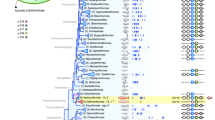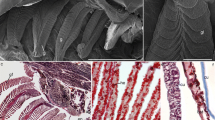Abstract
Nucleotide sequences of cDNA were used to construct antibodies against an aquaporin (AQP) expressed in the clawed toad, Xenopus laevis, viz., Xenopus AQP3, a homolog of mammalian AQP3. Xenopus AQP3 was immunolocalized in the basolateral membrane of the principal cells of the ventral skin, the urinary bladder, the collecting duct and late distal tubule of the kidney, the absorptive epithelial cells of the large intestine, and the ciliated epithelial cells of the oviducts. Therefore, we designated this AQP as basolateral Xenopus AQP3 (AQP-x3BL). The intensity of labeling for AQP-x3BL differed between the ventral and dorsal skin, with the basolateral membrane of the principal cells in the ventral skin showing intense labeling, whereas that in the dorsal skin was lightly labeled. AQP-x3BL was also immunolocalized in the basolateral membrane of secretory cells in the small granular and mucous glands of the skin. As AQP-x5, a homolog of mammalian AQP5, is localized in the apical membrane of these same cells, this provides a pathway for fluid secretion by the glands. Although Hyla AQP-h2 is translocated from the cytoplasm to the apical membrane of the Hyla urinary bladder in response to arginine vasotocin (AVT), AQP-h2 immunoreactivity in Xenopus bladder remains in the cytoplasm and barely moves to the apical membrane, regardless of AVT stimulation. AQP-x3 is localized in the basolateral membrane, even though the AVT-stimulated AQP-h2 does not translocate to the apical membrane. These findings provide new insights into AQP function in aquatic anurans.











Similar content being viewed by others
References
Agre P (2006) The aquaporin water channels. Proc Am Thorac Soc 3:5–13
Akabane G, Ogushi Y, Hasegawa T, Suzuki M, Tanaka S (2007) Gene cloning and expression of an aquaporin (AQP-h3BL) in the basolateral membrane of water-permeable epithelial cells in osmoregulatory organs of the tree frog. Am J Physiol Regul Integr Comp Physiol 292:R2340–R2351
Aoki M, Kaneko T, Katoh F, Hasegawa S, Tsutsui N, Aida K (2003) Intestinal water absorption through aquaporin 1 expressed in the apical membrane of mucosal epithelial cells in seawater-adapted Japanese eel. J Exp Biol 206:3495–3505
Bentley PJ (1966) The physiology of the urinary bladder of Amphibia. Biol Rev 41:275–316
Bentley PJ (2002) Endocrines and osmoregulation: a comparative account in vertebrates (2nd edn). Springer, Berlin Heidelberg New York
Bentley PJ, Main AR (1972) Zonal differences in permeability of the skin of some anuran Amphibia. Am J Physiol 223:361–363
Bentley PJ, Yorio T (1979) Do frogs drink? J Exp Biol 79:41–46
Calamita G, Gounon P, Gobin R, Bourguet J (1994) Antidiuretic response in the urinary bladder of Xenopus laevis: presence of typical aggrephores and apical aggregates. Biol Cell 80:35–42
Castillo GA, Orce GG (1997) Response of frog and toad skin to norepinephrine. Comp Biochem Physiol [A] 118:1145–1150
Deuchar EM (1975) Xenopus: the South African clawed frog. Wiley, London
Edgar WM (1992) Saliva: its secretion, composition and functions. Br Dent J 172:305–312
Engelhardt JF, Smith SS, Allen E, Yankaskas JR, Dawson DC, Wilson JM (1994) Coupled secretion of chloride and mucus in skin of Xenopus laevis: possible role for CFTR. Am J Physiol 267:C491–C500
Ewer RF (1952) The effects of posterior pituitary extracts on water balance in Bufo carens and Xenopus laevis, together with some general considerations of anuran water economy. J Exp Biol 29:429–439
Fujita A, Horio Y, Nielsen S, Nagelhus EA, Hata F, Ottersen OP, Kurachi Y (1999) High-resolution immunogold cytochemistry indicates that AQP4 is concentrated along the basal membrane of parietal cell in rat stomach. FEBS Lett 459:305–309
Gallardo P, Cid LP, Vio CP, Sepúlveda FV (2001)Aquaporin-2, a regulated water channel, is expressed in apical membranes of rat distal colon epithelium. Am J Physiol Gastrointest Liver Physiol 281:G856–G863
Gresz V, Kwon TH, Hurley PT, Varga G, Zelles T, Nielsen S, Case RM, Steward MC (2001) Identification and localization of aquaporin water channels in human salivary glands. Am J Physiol Gastrointest Liver Physiol 281:G247–G254
Hara M, Ma T, Verkman AS (2002) Selectively reduced glycerol in skin of aquaporin-3 deficient mice may account for impaired skin hydration, elasticity and barrier recovery. J Biol Chem 277:46616–46621
Hasegawa T, Tanii H, Suzuki M, Tanaka S (2003) Regulation of water absorption in the frog skins by 2 vasotocin-dependent water-channel aquaporins, AQP-h2 and AQP-h3. Endocrinology 144:4087–4096
Hasegawa T, Suzuki M, Tanaka S (2005) Immunocytochemical studies on translocation of phosphorylated AQP-h2 protein in granular cells of the frog urinary bladder before and after stimulation with vasotocin. Cell Tissue Res 322:407–415
Harvey BJ (1992) Energization of sodium absorption by H+-ATPase pump in michondria-rich cells of frog skin. J Exp Biol 172:289–309
Ishibashi K, Kuwahara M, Sasaki S (2000) Molecular biology of aquaporins. Rev Physiol Biochem Pharmacol 141:1–32
Ishida N, Hirai SI, Mita S (1997) Immunolocalization of aquaporin homologs in mouse lacrimal glands. Biochem Biophys Res Commun 238:891–895
Koefoed-Johnsen V, Ussing HH, Zerahn K (1952) The origin of the short-circuit current in the adrenaline stimulated frog skin. Acta Physiol Scand 27:38–48
Koyama Y, Yamamoto T, Tani T, Nihei K, Kondo D, Funaki H, Yaoita E, Kawasaki K, Sato N, Hatakeyama K, Kihara I (1999) Expression and localization of aquaporins in rat gastrointestinal tract. Am J Physiol 276:C621–C627
Kubota M, Hasegawa T, Nakakura T, Tanii H, Suzuki M, Tanaka S (2006) Molecular and cellular characterization of a new aquaporin, AQP-x5, specifically expressed in the small granular glands of Xenopus skin. J Exp Biol 209:3199–3208
Lillywhite HB (1971) Temperature selection by the bullfrog, Rana catesbeiana. Comp Biochem Physiol [A] 40:213–227
Lillywhite HB (2006) Water relations of tetrapod integument. J Exp Biol 209:202–226
Loveridge J (1970) Observations on nitrogenous excretion and water relations of Chiromantis xerampelina (Amphibia, Anura). Arnoldia 5:1–6
Matsuzaki T, Suzuki T, Koyama H, Tanaka S, Takata K (1999) Water channel protein AQP3 is present in epithelial expsoed to the environment of possible water loss. J Histochem Cytochem 47:1275–1286
Ma T, Hara M, Sougrat R, Verbavatz JM, Verkman AS (2002) Impaired stratum corneum hydration in mice lacking epidermal water channel aquaporin-3. J Biol Chem 277:17147–17153
Mills JW (1985) Ion transport across the exocrine glands of the frog skin. Pflügers Arch 405 (Suppl 1):S44–S49
Moore M, Ma T, Yang B, Verkman AS (2000) Tear secretion by lacrimal glands in transgenic mice lacking water channels AQP1, AQP3, AQP4 and AQP5. Exp Eye Res 70:557–562
Nielsen R (1990) Isotonic secretion via frog skin glands in vitro. Water secretion is coupled to the secretion of sodium ions. Acta Physiol Scand 139:211–221
Nielsen S, King LS, Christensen BM, Agre P (1997) Aquaporins in complex tissues. II. Subcellular distribution in respiratory and glandular tissues of rat. Am J Physiol 273:C1549–C1561
Nielsen S, Frokiaer J, Marples D, Kwon TH, Agre P, Knepper MA (2002) Aquaporins in the kidney: from molecules to medicine. Physiol Rev 82:205–244
Schreiber R, Pavenstadt H, Greger R, Kunzelmann K (2000) Aquaporin 3 cloned from Xenopus laevis is regulated by the cystic fibrosis transmembrane conductance regulator. FEBS Lett 475:291–295
Schlisio W, Jurss K, Spannhof L (1975) Osmotic and ionic regulation in Xenopus laevis Daud. during adaptation to different osmotic environments–V. Quantitative alterations of the acid glycosaminoglycans in the kidney. Comp Biochem Physiol [B] 51:363–369
Sorensen JB, Nielsen MS, Gudme CN, Larsen EH, Nielsen R (2001) Maxi K+ channels co-localised with CFTR in the apical membrane of an exocrine gland acinus: possible involvement in secretion. Pflugers Arch 442:1–11
Suzuki M, Hasegawa T, Ogushi Y, Tanaka S (2007) Amphibian aquaporins and adaptation to terrestrial environments: a review. Comp Biochem Physiol [A] Mol Integr Physiol 148:72–81
Takata K, Matsuzaki T, Tajika Y (2004) Aquaporins: water channel proteins of the cell membrane. Prog Histochem Cytochem 39:1–83
Tanaka S, Kurosumi K (1992) A certain step of proteolytic processing of proopiomelanocortin occurs during the transition between two distinct stages of secretory granules maturation in rat anterior pituitary corticotrophs. Endocrinology 131:779–786
Tanaka S, Yora T, Nakayama K, Inoue K, Kurosumi K (1997) Proteolytic processing of pro-opiomelanocortin occurs in acidifying secretory granules of AtT-20 cells. J Histochem Cytochem 45:425–436
Tanaka S, Hasegawa T, Tanii H, Suzuki M (2005) Immunocytochemical and phylogenetic distribution of aquaporins in the frog ventral skin and urinary bladder. Ann N Y Acad Sci 1040:483–485
Tanii H, Hasegawa T, Hirakawa N, Suzuki M, Tanaka S (2002) Molecular and cellular characterization of a water channel protein, AQP-h3, specifically expressed in the frog ventral skin. J Membr Biol 188:43–53
Uchiyama M, Yoshizawa H (2002) Nephron structure and immunohistochemical localiztion of ion pumps and aquaporins in the kidney of frogs inhabiting different environments. In: Hazon N, Flik G (eds) Osmoregulation and drinking in vertebrates. BIOS Scientific, Oxford, pp 109–128
Xiang X, Burnett L, Rawls A, Bieber A, Chandler D (2004) The sperm chemoattractant “allurin” is expressed and secreted from the Xenopus oviduct in a hormone-regulated manner. Dev Biol 275:343–355
Yajima S, Kubota M, Nakakura T, Hasegawa T, Katagiri N, Tomura H, Sasayama Y, Suzuki M, Tanaka S (2007) Cloning and expression of the vacuolar proton-pumping ATPase subunits in the follicular epithelium of bullfrog endolymphatic sac. Zool Sci 24:147–157
Yoshizaki N (1985) Fine structure of oviducal epithelium of Xenopus laevis in relation to its role in secreting egg envelopes. J Morphol 184:155–169
Author information
Authors and Affiliations
Corresponding author
Additional information
This investigation was supported in part by a grant-in aid for science research from the Ministry of Education, Science, Sports, and Culture of Japan to S.T.
Rights and permissions
About this article
Cite this article
Mochida, H., Nakakura, T., Suzuki, M. et al. Immunolocalization of a mammalian aquaporin 3 homolog in water-transporting epithelial cells in several organs of the clawed toad Xenopus laevis . Cell Tissue Res 333, 297–309 (2008). https://doi.org/10.1007/s00441-008-0628-2
Received:
Accepted:
Published:
Issue Date:
DOI: https://doi.org/10.1007/s00441-008-0628-2




